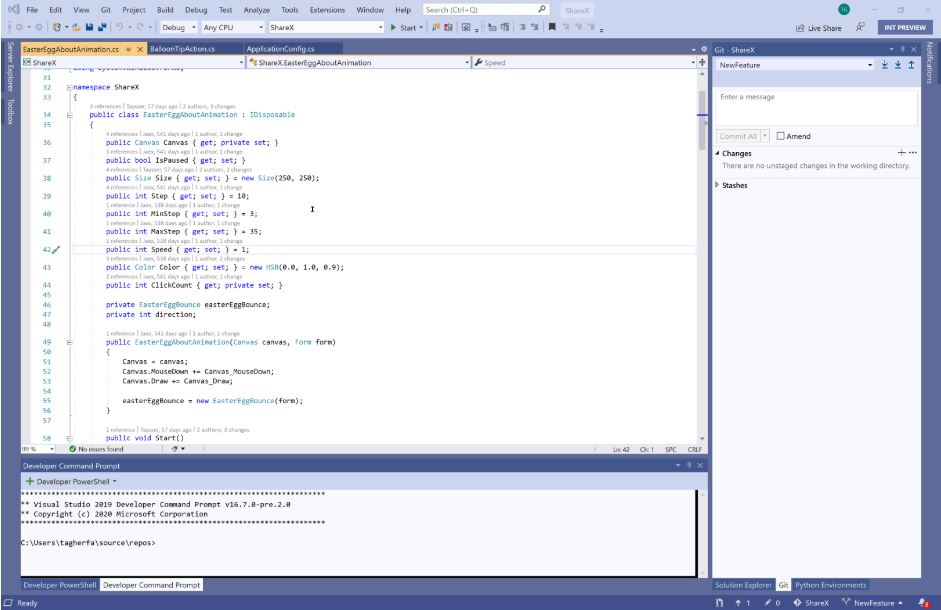News
Visual Studio 2019 v16.7 Ships with Better Git Integration
Better GitHub integration and other improvements highlight the new Visual Studio 2019 Version 16.7 and first preview of v16.8, both released today.
The focus on Git, a distributed source code version control system, is hardly surprising since Microsoft acquired GitHub in 2018, and Visual Studio 2019 v16.7 (following May's v16.6) sees better Git integration in several ways:
- A revamped Visual Studio merge editor is decoupled from Team Foundation Version Control and now focuses on Git
- Git conflict resolution on one side or the other is improved by a one-click checkbox
- A new Git Repository window gives developers a complete full-screen experience to focus on dedicated Git activities
 [Click on image for larger, animated GIF view.] Managing branches and viewing history in a focused Git Repository window in animated action (source: Microsoft).
[Click on image for larger, animated GIF view.] Managing branches and viewing history in a focused Git Repository window in animated action (source: Microsoft).
That latter item, the Git Repository window, sees even more improvements in Visual Studio 2019 v16.8 Preview 1, also released today. "Since we’ve first released it, we’ve made several modifications to the Git Repository window to more easily navigate through it," the team said. "Use the View menu or the keyboard chord Ctrl+0, Ctrl+S to quickly open the window. And customize the history view through a new tool bar with filters. You can also search for commits in the branch history using the search box. If you want to update the branch with the latest commits, you can use the new Fetch, Pull, and Push commands in the incoming and outgoing commits."
Besides better Git integration, the post announcing Visual Studio 2019 v16.7 (a long-term servicing release) highlights:
XAML Tools WPF/UWP
- Design-time Data: This lets developers see controls filled with data during design-time development -- before data binding or data sources are available -- by letting them set values that are only visible in the designer (a "d:" designation keeps them from being compiled into binaries) for each control.
- XAML Designer Refresh Button: When facing rendering issues, developers no longer need to close and then re-open the designer view, as they can instead just click a new XAML Designer Refresh Button.
- XAML Code Editor: This now delineates WPF. NET Core, WPF, .NET Framework and Xamarin.Forms projects with colored icons.
C++
- AddressSanitzer: This runtime memory error detector for C/C++ gets support for both 64-bit projects and debug builds, adding to the previous support for 32-bit x86 projects on Windows that has been available since Visual Studio 2019 v16.4.
- Edit and Set Default Remote SSH Connections: Developers can now can now edit and set default remote SSH connections -- edit an existing remote connection (for example if its IP address is changed) and set default connections to be consumed in CMakeSettings.json and launch.vs.json -- from directly within the Connection Manager.
-
Extended Support for Debugging CMake Projects and Linux Distributions and Shells: Here, the team:
- Added first-class support for debugging CMake projects on remote systems with gdbserver
- Extended support for different Linux distributions and shells
- Enabled the use of Ninja to speed up incremental builds when using MSBuild to build Linux applications
- Implemented many C++20 features in its STL implementation
.NET Productivity:
- IntelliSense Update: Developers can leverage IntelliSense completion in DateTime and TimeSpan string literals by placing the caret inside the DateTime or TimeSpan string literal and pressing (Ctrl + Space), which will present completion options and explanations of what each character means (both the date time format and an example will be provided).
- Quick Actions and Refactorings Menu Update: Developers can now add a parameter within the Change Signature dialog by placing the caret at the declaration or usage of a method and pressing (Ctrl+.) to trigger the Quick Actions and Refactorings menu. From there, they can Select Change signature and within the resulting dialog select Add to add a parameter.
- Add a Debugger Display Attribute: Developers can now pin properties within the debugger programmatically in their code via a quick action to add a debugger display attribute to a class.
- Profiler: A new .NET Performance Counters tool added to the profiler helps developers visualize and analyze dotnet counters, which are high-level performance metrics such as cpu usage or exception count that provide insights into how an application is performing.
More detailed information on all of the above and much more can be found in the release notes.
"Visual Studio 2019 version 16.7 is the third supported servicing baseline for Visual Studio 2019," Microsoft said. "Consequently, Enterprise and Professional customers needing to adopt a long term stable and secure development environment are encouraged to standardize on this version. As explained in more detail in our lifecycle and support policy, version 16.7 will be supported with fixes and security updates for one year after the release of the next servicing baseline."
About the Author
David Ramel is an editor and writer at Converge 360.